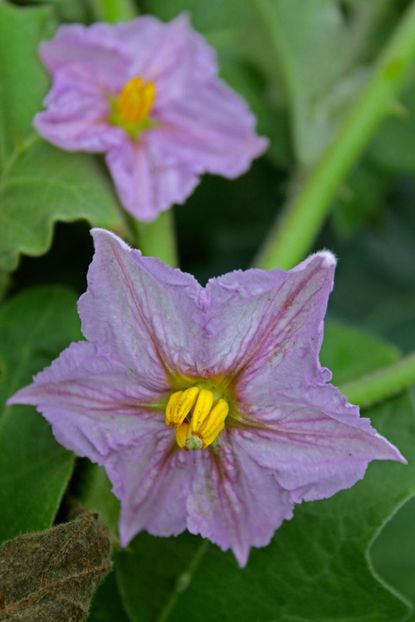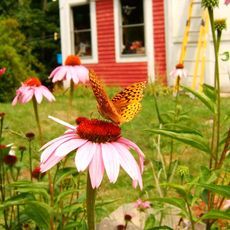Can You Hand Pollinate An Eggplant: Tips For Pollinating Eggplants By Hand


Eggplant blossoms need pollination in order to produce an eggplant. Generally speaking, they only need a draft of light wind or stirring of the surrounding air caused by the gardener walking nearby, or as in my case, the cat chasing bugs through the garden. On occasion, however, something goes awry-- an eggplant pollination problem as it were. This has led me to wonder if I may be of assistance; in other words, how can you hand pollinate eggplant flowers?
Can You Hand Pollinate an Eggplant?
Just as it may be difficult to explain how babies are made to your child, understanding the exact mechanics required to produce fruit on an eggplant can be complex. Basically, there are two types of plants-- those that need both male and female blossoms to produce and those that have only one type of flower that contains everything it needs to bloom. The latter are referred to as “perfect,” “bisexual,” or “complete” flowers. The former count zucchini, cucumber, and watermelon among them, while “perfect” blooms include eggplant and beans. The process of hand pollinating eggplants is slightly different than for squash or cukes, but yes, pollinating eggplants by hand is definitely doable.
How to Hand Pollinate Eggplant Flowers
Eggplant flowers contain both pollen producing anthers and pollen receiving pistils, which only take a bit of air movement to move the pollen from one to the other. As mentioned, despite this seemingly perfect system, eggplant pollination problems may still plague the gardener. You can plant a garden that attracts pollinators, increase air circulation, or hand transfer pollen. Hand pollinating eggplant isn't rocket science. On the contrary, it's very simple and can be done with your hand by lightly tapping the flower daily during the blooming season from mid to late summer, 70 to 90 days post germination. The goal is to shift the pollen from the anther to the waiting pistil. Another way to transfer the pollen to the pistil is to use a delicate brush, like those for fine art or even makeup application. You can also use a soft cotton swab. Gently pick up pollen from inside the flower and move it around. Whichever method you use for pollinating eggplants by hand, the ideal time is in the morning between 6 and 11 a.m. However, in a pinch, hand pollinating eggplants can occur in the afternoon. You'll have success when the flower closes but does not fall from the plant. This is a sure sign to expect a tiny eggplant soon. If this sounds like too much monkey business to you, you can try to increase pollination by planting flowers that will attract bees. While eggplant doesn't rely on pollinators, they can certainly be helpful buzzing around, creating air currents and moving pollen around. In an environment such as a greenhouse, pollination for “perfect” types of plants may be thwarted by the lack of air currents and/or pollinators. In this instance, setting a fan to lightly blow through the crop will increase the chances for pollination.
Gardening tips, videos, info and more delivered right to your inbox!
Sign up for the Gardening Know How newsletter today and receive a free download of our most popular eBook "How to Grow Delicious Tomatoes."

Amy Grant has been gardening for 30 years and writing for 15. A professional chef and caterer, Amy's area of expertise is culinary gardening.
-
 Turn Your Yard Into A Wildlife Habitat: 10 Easy Ways To Make A Wildlife Sanctuary
Turn Your Yard Into A Wildlife Habitat: 10 Easy Ways To Make A Wildlife SanctuaryYou may be dreaming about ways to turn your yard into a wildlife habitat. We say, follow your dreams!
By Teo Spengler
-
 Gardening Makes You Live Longer, According To Research – How To Reap The Benefits
Gardening Makes You Live Longer, According To Research – How To Reap The BenefitsIt's obvious that gardening makes you live longer, but it’s nice to know research supports the idea.
By Mary Ellen Ellis